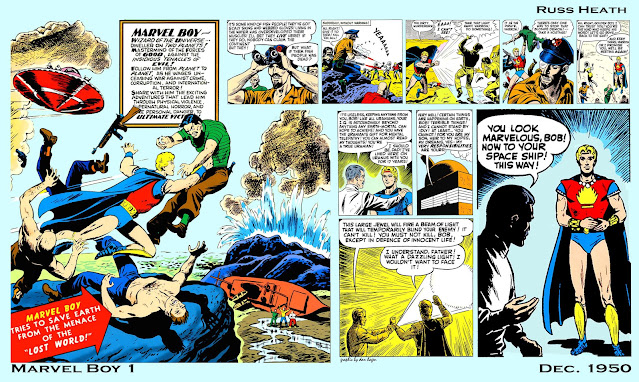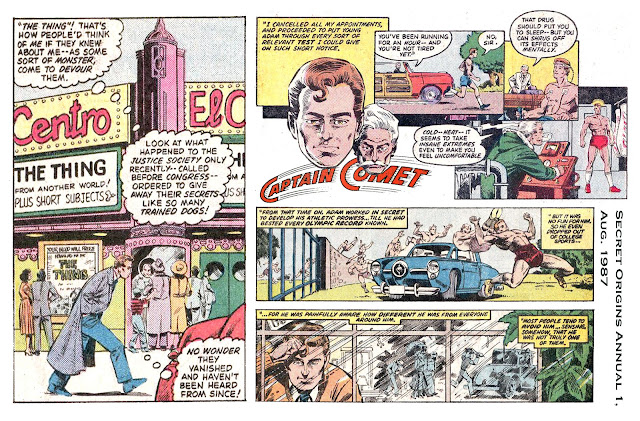December 1950: The Boy Before Captain Comet
Superheroes are supposed to appear just in time. But like his contemporary Captain Comet, Marvel Boy arrived either too late or too soon.
These two Marvel and DC superheroes were transitional characters that represented a shift from World War II to the space age. Appropriately enough for futuristic figures, both were at least a decade ahead of time.
Superheroes were distinctly out of fashion in the early 1950s, and wouldn’t be popular again until the very end of the decade. But it’s no coincidence that two of the first postwar superheroes shared the power of super-intelligence — were in fact so intelligent that they were telepathic.
The product of human intelligence had, after all, ended World War II with two nuclear detonations in 1945, making it blindingly clear to the world that intelligence was power.
Like Captain Comet, Marvel Boy also had a space ship in which to zoom around. Both characters were aimed at the zeitgeist of the era, combining the superheroes that had become popular in the late 1930s with the flying saucer phenomenon that fascinated the world beginning in the late 1940s.
“Like Superman, Marvel Boy was rocketed to another planet as a baby, when the one he'd been born on was struck with a terrible disaster,” noted comics historian Don Markstein. “In his case, the planet he left was Earth, and the disaster was the Nazi take-over of Germany in the 1930s, which resulted in the deaths of his mother and sister.
“His father, Professor Matthew Grayson, had been working on a uranium-powered rocket, and took their deaths as his cue to take baby Bob and fly off to found a tiny, all-male colony on the Moon. They wound up on Uranus instead.”
Like Wonder Woman’s Paradise Island or Superman’s Krypton, Marvel Boy’s Uranus was an enlightened society devoted to intellectual and aesthetic pursuits, one that had transcended killing and greed.
Growing up in that advanced society, Bob developed telepathy and an IQ comparable to the average Uranian’s, which was 356. Albert Einstein’s IQ, by contrast, was about 160.
Bob’s physical powers were impressive, but only that. He could, his father told him, “…run faster and fight a little harder than mortal man — but that’s all.”
The superhero’s first adventure, Marvel Boy and the Lost World (Marvel Boy 1, Dec. 1950) was drawn by Russ Heath and may well have been written by a 27-year-old Stan Lee. If so, Lee was going through a loquacious phase, because those word balloons are crowded.
Prof. Grayson sends his 17-year-old son back to Earth because a lost continent has arisen in the South Atlantic, wrecking ships and sending tidal waves across the coasts.
“All the nations of the world will fight to control it!” the professor tells his son. “You must keep this lost continent out of the hands of greedy men, or else its appearance can be a disaster!”
Bob had already telepathically sensed the mission his father had in mind for him. “I understand, dad,” he said. “You want me to go to Earth in order to save it from self-destruction! By combating all elements, political and criminal, who seek to destroy it!”
Clad in his red Uranian tunic and blue cape, Bob returned to Earth armed with a non-lethal weapon — a jewel mounted in an armband that could project a blinding light.
Marvel Boy’s version of Wonder Woman’s invisible plane was first a flying saucer and then a sleek rocket ship, the Silver Bullet.
Perhaps he’d listened to the Lone Ranger radio broadcasts on Uranus.
Marvel Boy’s first mission turned out to be, somewhat surprisingly, a repudiation of colonialism. Decolonization — the dismantling of colonial empires established prior to World War I — was a big topic just after World War II.
Marvel Boy discovers that the pirate Count Varron has claimed the new continent, and questions his right to do so.
“Rights?” replies one of Varron’s cutthroats. “Who needs rights? We got guns! Mow this freak down, men!”
But Marvel Boy’s speed and strength and blinding ray overwhelm the pirates, and as he continues his aerial survey of the new land, he spots its indigenous population — green-skinned fish people whom he befriends.
“They’re men!” Marvel Boy thinks. “This changes everything! A country always belongs to its inhabitants! Neither Varron nor any nation can claim this continent now!”
Conversing via telepathy, Marvel Boy learns that the fish men were descended from surface dwellers whose continent sank beneath the waves centuries before.
Meanwhile, Varron decides his claim would be valid if he simply machine-gunned the native population in an ambush. Varron slaughters several fish men before Marvel Boy fights the pirates off.
When Varron uses explosives in an attempt to seal the fish people into their caves, he inadvertently triggers an earthquake that drowns his men as the indigenous people sinks safely back beneath the ocean.
As Marvel Boy soars overhead in his flying saucer, the drowning Varron rabes, ”It’s my continent! All mine! Varronland!”
After a handful of issues, Marvel Boy would sink without a trace, too.
“The heyday of superheroes had been in the early 1940s, and they wouldn't return in a big way until the '60s,” Markstein noted. “Like Fighting American, Captain Flash, The Avenger and most others that started in the '50s, Marvel Boy didn't last very long. With the third issue, the title of his comic was changed to Astonishing. He continued to be its cover-featured star, but only for another four issues. After #6 (October, 1951) it only ran fantasy/horror stories without continuing characters.”






ReplyDeleteDillon Black wrote: A retcon of Marvel Boy's first adventure would make the green-skinned underwater dwellers of the risen lost continent the Lemurians from the Sub-Mariner comic books.
Cheryl Spoehr wrote: I recall Marvel Boy reprints in Marvel Super Heroes, I think. Unlike Captain Comet, he never impressed me. I recall his costume came back in the seventies, but with a different person with different abilities in it. No offense meant to Marvel Boy and his fans... but this one seemed awfully weak to me. The idea of telepathy and being just a little stronger then Earth warriors is interesting tho... seems he has more Doc Savage in him then Superman.
ReplyDeleteFranklin Too wrote:
ReplyDeleteSuperheroes were on the decline and those two were superhero/science fiction hybrids. The Marvel Boy stories were beautifully illustrated and of a ore serious nature than Captain Comet's but both were enjoyable. Comics today don't have that kind of class.
Bill Schelly in American Comics Book Chronicles: "Stan Lee tried a new costumed hero title, Marvel Boy, cover dated December 1950. This project had top ight art by Russ Heath, one of the rising stars of this era who would do a great deal of work for Goodman’s comics throughout the decade. Marvel Boy #1 was a good-looking book, and Bill Everett’s work in subsequent issues was also excellent, but it apparently failed to attract enough readers. It was re-titled Astonishing with the third issue, and Marvel Boy was gradually de-emphasized, vanishing into comic book limbo after issue #6."
ReplyDelete